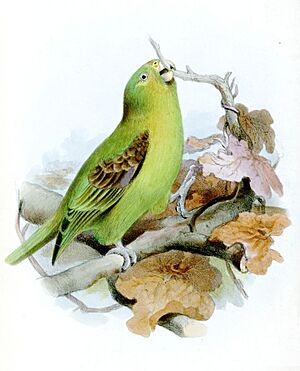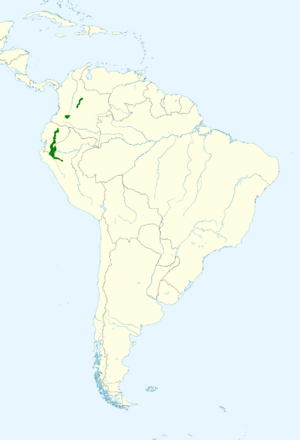Spot-winged parrotlet facts for kids
Quick facts for kids Spot-winged parrotlet |
|
|---|---|
 |
|
| Conservation status | |
| Scientific classification | |
| Genus: |
Touit
|
| Species: |
stictopterus
|
 |
|
| Synonyms | |
|
Touit stictoptera (lapsus) |
|
The spot-winged parrotlet (Touit stictopterus) is a small, colorful bird that belongs to the parrot family. It is considered a Near Threatened species, meaning its population is decreasing and it needs protection. You can find this special bird in the forests of Colombia, Ecuador, and Peru.
Contents
About the Spot-winged Parrotlet
The spot-winged parrotlet is a unique species, meaning there are no different types or subspecies of it. Scientists once thought there might be a separate kind of parrotlet called T. emmae, but they later found out it was just a female spot-winged parrotlet!
What Does It Look Like?
This parrotlet is about 17 to 18 centimeters (7 inches) long, which is about the size of a small ruler. It weighs between 71 and 84 grams (about 3 ounces), which is like weighing a few chocolate bars. Its body, head, and tail are mostly green. The green on its back is darker than the green on its belly.
The male parrotlet has special wings that give the bird its name. His wings are a dark brown, and the tips of some of his feathers have whitish spots. Two of these feathers even have orange tips! Female parrotlets have green feathers on their wings with black bases, so they look a bit different from the males.
Where Does It Live?
The spot-winged parrotlet lives in a few separate areas along the eastern side of the Andes mountains. You can find it from central Colombia, through Ecuador, and down into northern Peru. It mostly prefers to live in old, wet mountain forests. However, it can also be seen in more open areas like savannas or even in small, stunted forests on top of ridges. In Peru, it seems to prefer forests where the soil isn't very rich.
These birds usually live at elevations between 1,050 and 1,700 meters (about 3,400 to 5,600 feet) above sea level. But sometimes they are found as low as 500 meters (1,600 feet) or as high as 2,400 meters (7,900 feet).
Behavior and Habits
Movement
Scientists believe the spot-winged parrotlet is a "sedentary" bird. This means it tends to stay in one area and does not migrate or travel long distances.
What Does It Eat?
Spot-winged parrotlets often look for food in small groups. Their diet mainly consists of fruits and seeds. They have also been seen eating corn from fields and even termites in Colombia!
Reproduction
Not much is known about how spot-winged parrotlets raise their young. In Ecuador, there's some evidence that their breeding season might include March, but more research is needed to be sure.
How Does It Communicate?
When these parrotlets fly, they make a harsh, repeated call that sounds like "ddreet-ddreet-ddreet-ddreet." When a group of them calls at the same time, it creates a loud, continuous chattering sound. They also make a quick chattering noise that sounds like "wi-chi-chi."
Protecting the Spot-winged Parrotlet
The IUCN (International Union for Conservation of Nature) has changed the status of the spot-winged parrotlet a few times. It was once listed as "Threatened" and then "Vulnerable." Since 2021, it has been classified as "Near Threatened." This means it's not in immediate danger of disappearing, but it's close, and its population is shrinking.
There are an estimated 5,000 to 21,000 adult spot-winged parrotlets left in the wild. The biggest threat to these birds is the ongoing loss of their forest homes. People are cutting down forests for farming and building new settlements, even in areas that are supposed to be protected. This makes it harder for the parrotlets to find food and safe places to live. Protecting their forest habitat is very important to help these beautiful birds survive.


